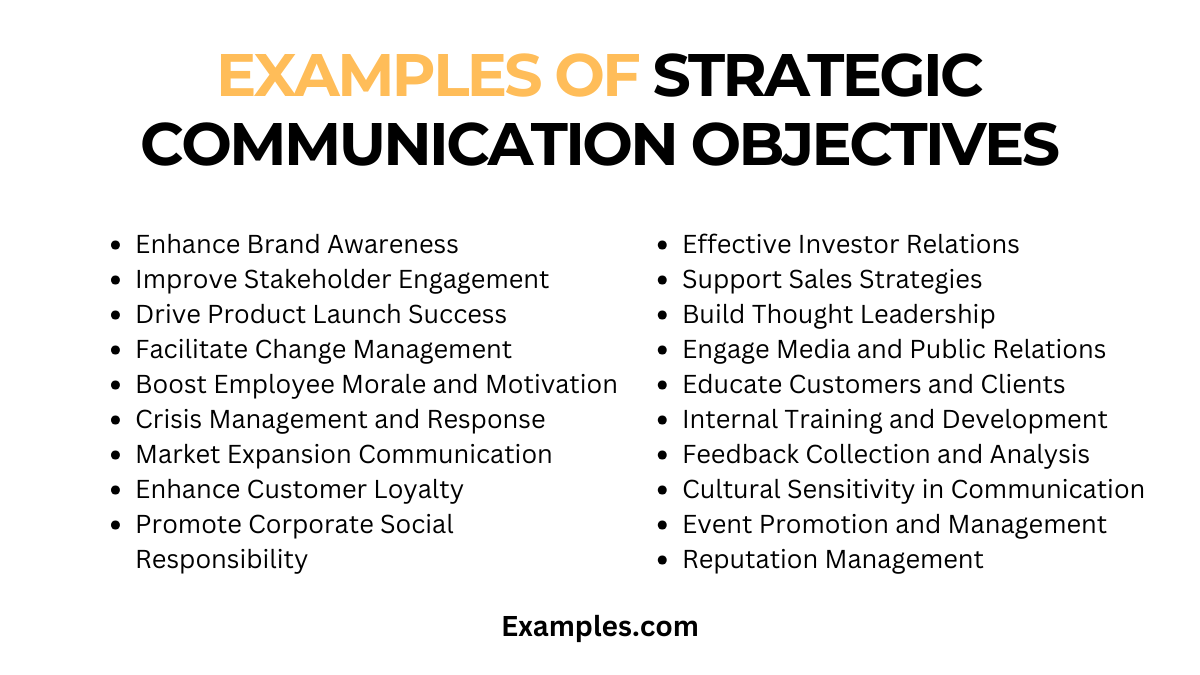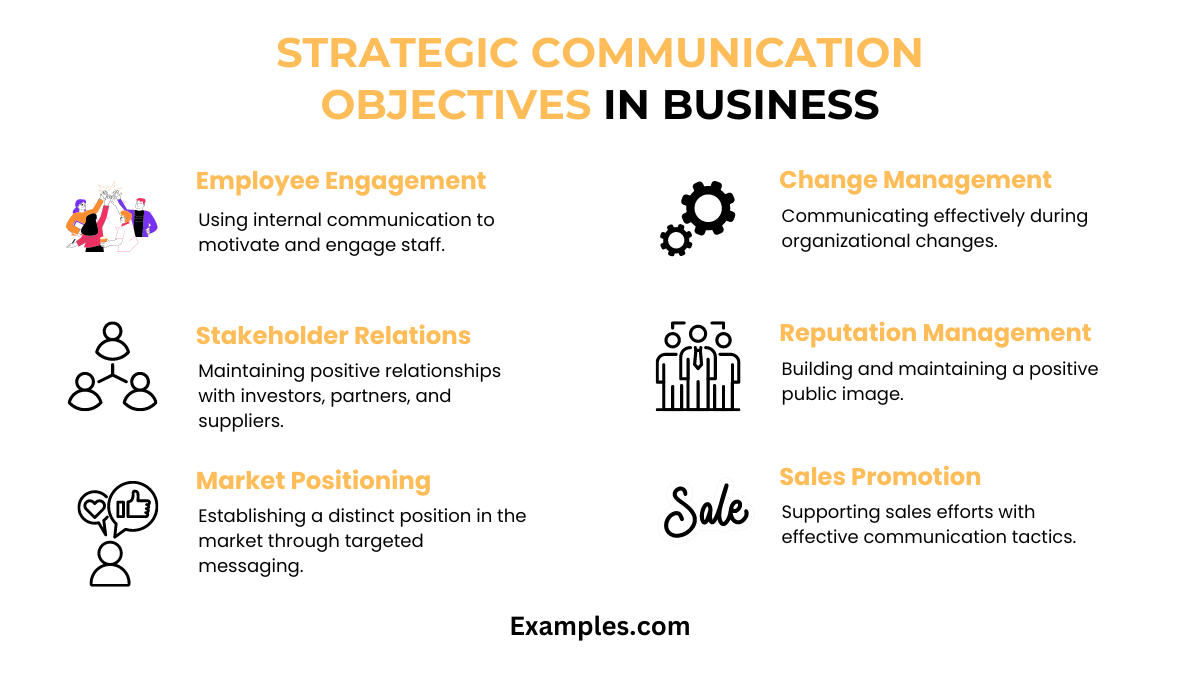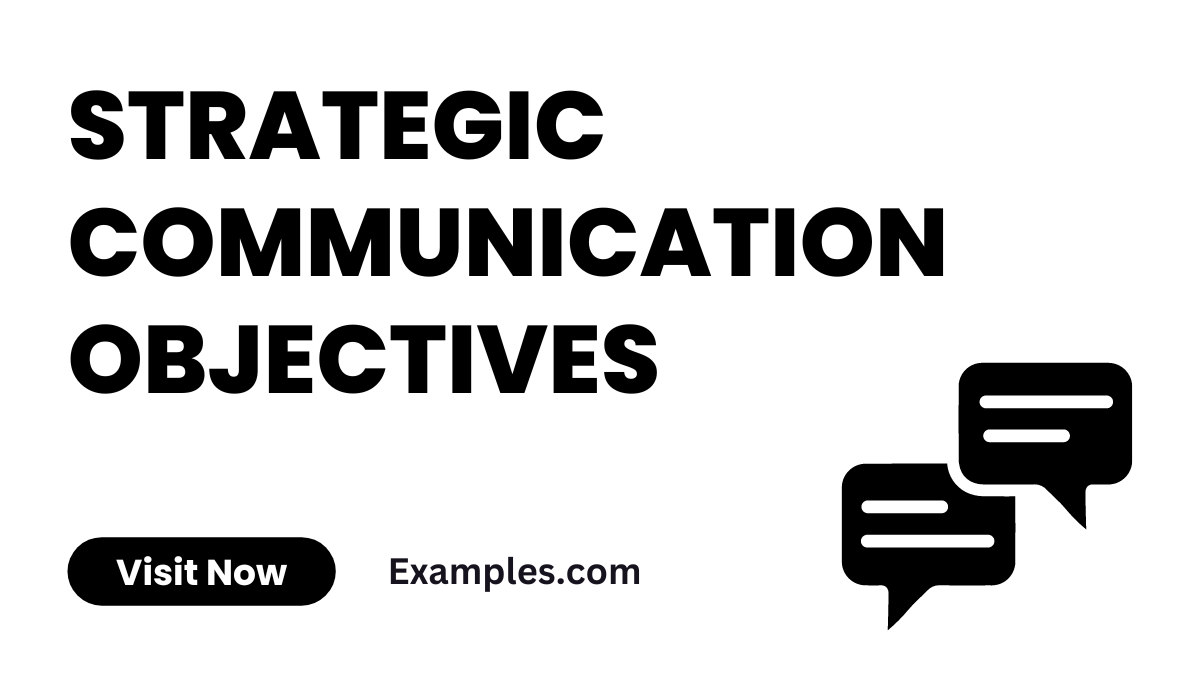19+ Strategic Communication Objectives Examples
Strategic Communication Objectives are essential for effectively conveying a company’s message and achieving its goals. This guide explores various examples and methodologies, demonstrating how to craft objectives that resonate with audiences and drive results. By incorporating examples of communication objectives, we’ll delve into how these objectives can be aligned with business strategies to enhance overall communication effectiveness. Whether you’re a PR professional, marketer, or corporate communicator, understanding and applying these principles is key to influencing your target audience and achieving your communication goals.
20 Examples of Strategic Communication Objectives

- Enhance Brand Awareness: Increase public recognition and understanding of your brand.
Example: Launch a multi-channel marketing campaign featuring the unique values and vision of your brand. - Improve Stakeholder Engagement: Strengthen relationships with key stakeholders through targeted communication.
Example: Organize a stakeholder meeting to discuss company developments and gather feedback. - Drive Product Launch Success: Effectively communicate the features and benefits of a new product.
Example: Implement an email campaign highlighting the innovative aspects of the new product. - Facilitate Change Management: Communicate effectively during organizational changes to ensure smooth transitions.
Example: Develop a series of informative webinars to guide employees through new processes. - Boost Employee Morale and Motivation: Foster a positive work environment through motivational internal communication.
Example: Send monthly newsletters celebrating team achievements and individual contributions. - Crisis Management and Response: Develop swift and transparent communication strategies during crises.
Example: Release timely and honest updates to stakeholders during a crisis to maintain trust. - Market Expansion Communication: Communicate effectively to support entry into new markets.
Example: Craft culturally sensitive marketing materials for new regional audiences. - Enhance Customer Loyalty: Build and maintain strong relationships with customers through consistent communication.
Example: Create a loyalty program with regular updates and exclusive offers for members. - Promote Corporate Social Responsibility: Share your company’s efforts in social and environmental initiatives.
Example: Publish an annual report on your company’s sustainability practices and community involvement. - Lead Generation and Nurturing: Use strategic communication to attract and nurture potential leads.
Example: Develop a content marketing strategy focused on educational materials that address customer pain points. - Effective Investor Relations: Maintain transparent and regular communication with investors.
Example: Provide quarterly investor briefings with updates on financial performance and strategic direction. - Support Sales Strategies: Align communication efforts with sales objectives for enhanced results.
Example: Create sales enablement materials that clearly articulate product benefits and unique selling points. - Build Thought Leadership: Establish your brand as a thought leader in the industry.
Example: Publish insightful articles and research papers on industry trends and innovations. - Engage Media and Public Relations: Develop strong relationships with media for positive brand coverage.
Example: Host press events to showcase new initiatives and forge media relationships. - Educate Customers and Clients: Provide valuable information to help customers make informed decisions.
Example: Develop an educational video series explaining how to use your products effectively. - Internal Training and Development: Communicate training opportunities to employees for skill enhancement.
Example: Announce a new e-learning platform for employee skill development. - Feedback Collection and Analysis: Gather and analyze feedback to improve communication strategies.
Example: Conduct surveys to assess the effectiveness of recent marketing campaigns. - Cultural Sensitivity in Communication: Adapt messaging to respect and embrace cultural differences.
Example: Tailor marketing messages to reflect cultural norms and values in different regions. - Event Promotion and Management: Effectively communicate about upcoming events to maximize attendance and engagement.
Example: Use social media and email marketing to promote and provide updates about a major industry event. - Reputation Management: Monitor and manage your brand’s reputation through strategic communication.
Example: Implement a social listening tool to track and respond to brand mentions online.
Each of these objectives, along with their corresponding examples, illustrates the breadth and depth of strategic communication objectives, providing a comprehensive understanding of how they can be utilized to enhance various aspects of a business’s communication strategy.
Smart Goals for Strategic Communication Objectives
- Specific Messaging: Craft messages that are clear and directly address the target audience’s needs and preferences.
Example: Tailoring social media posts to address common customer queries. - Measurable Outcomes: Set goals that can be quantified, like a certain percentage increase in audience engagement.
Example: Aiming for a 20% increase in social media interactions within three months. - Achievable Tactics: Ensure strategies are realistic and attainable with available resources.
Example: Implementing a monthly newsletter with current staffing and budget. - Relevant Content: Create content that aligns with both organizational goals and audience interests.
Example: Developing blog posts that highlight industry trends relevant to the company’s services. - Time-Bound Plans: Set clear deadlines for achieving communication objectives.
Example: Launching a marketing campaign for a new product release by the next quarter. - Audience-Centric Approach: Focus on understanding and meeting the needs of your target audience.
Example: Conducting surveys to understand customer preferences and tailor communications accordingly. - Brand Consistency: Maintain a consistent brand voice and image across all communication channels.
Example: Ensuring all marketing materials reflect the brand’s core values and style. - Feedback Loops: Incorporate mechanisms for receiving and integrating feedback.
Example: Setting up a system for monitoring customer reviews and responding appropriately. - Crisis Management Readiness: Prepare for potential crises with proactive communication strategies.
Example: Developing a crisis communication plan to handle any negative publicity. - Continuous Improvement: Regularly review and adjust strategies based on performance analytics.
Example: Analyzing campaign results each quarter to refine future communication efforts.
What are the Elements of Strategic Communication Objectives
- Audience Analysis: Understanding who the message is for and tailoring the communication accordingly.
- Message Clarity: Ensuring the message is understandable and unambiguous.
- Channel Selection: Choosing the most effective mediums for conveying the message.
- Consistency: Maintaining a consistent tone and style across all communication.
- Feedback Mechanisms: Incorporating ways to receive audience feedback.
- Goal Alignment: Ensuring communication aligns with broader organizational goals.
- Flexibility: Being able to adapt strategies based on changing circumstances.
- Budget Considerations: Managing resources effectively for communication initiatives.
- Legal and Ethical Compliance: Adhering to legal standards and ethical practices in communication.
- Evaluation and Measurement: Assessing the effectiveness of communication strategies.
Strategic Communication Objectives in Business

- Brand Awareness Enhancement: Increasing visibility and recognition of the brand in the market.
- Employee Engagement: Using internal communication to motivate and engage staff.
- Stakeholder Relations: Maintaining positive relationships with investors, partners, and suppliers.
- Market Positioning: Establishing a distinct position in the market through targeted messaging.
- Change Management: Communicating effectively during organizational changes.
- Reputation Management: Building and maintaining a positive public image.
- Sales Promotion: Supporting sales efforts with effective communication tactics.
- Customer Retention: Keeping existing customers engaged and loyal.
- Corporate Social Responsibility (CSR) Communication: Sharing the company’s CSR initiatives and impact.
- Crisis Communication: Managing communication effectively during crises.
Strategic Communication Objectives in Marketing
Strategic communication objectives are crucial in guiding marketing efforts and ensuring that all communications align with the overarching goals of the organization. Here are ten key objectives in marketing:
- Enhancing Brand Awareness: Strategic communications aim to increase the visibility and recognition of a brand. This involves utilizing various channels to reach a wider audience and imprint the brand identity in their minds.
- Building Customer Loyalty: Consistent and positive messaging helps in developing a loyal customer base. This includes engaging with customers through personalized content and rewarding loyalty.
- Generating Leads: A fundamental objective is to create interest among potential customers, converting them into leads. This involves targeted campaigns and persuasive messaging to attract prospects.
- Supporting Product Launches: Communication strategies are tailored to create buzz around new product launches. This includes teasers, launch events, and press releases to generate interest and anticipation.
- Facilitating Market Expansion: When entering new markets, strategic communication focuses on adapting the messaging to resonate with the new audience while maintaining brand consistency.
- Driving Sales: A direct objective of strategic communication is to encourage purchases. This involves promotional campaigns and persuasive calls-to-action that lead to increased sales.
- Improving Customer Relationships: Effective communication helps in nurturing and maintaining strong relationships with customers. This includes feedback mechanisms and customer support initiatives.
In marketing, strategic communication objectives serve as a roadmap, guiding all messaging and tactics towards achieving specific goals. Whether it’s enhancing brand awareness, driving sales, or managing reputation, these objectives ensure that every communication effort is purposeful and aligned with the broader vision of the organization. Crafting these objectives requires a deep understanding of the brand, market dynamics, and customer behavior, making them a critical component in the success of marketing strategies.



